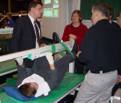The most complicated functions of the brain presuppose the normal functioning of nerve cells both individually and in combination. For their activity they need energy that has to be produced in cell metabolism. As one of the most metabolically active organs, the brain needs a third of the blood circulating in the body for its supply of oxygen and nutrients. As energy supplier, dextrose and glucose respectively, are oxidativally burnt, that is, decomposed, in the presence of oxygen.
The cell is supplied with both glucose and oxygen through the blood. Minor fluctuations in the provision of these energy suppliers are easily compensated for by healthy, functioning cerebral vascular systems. The situation only begins to become critical once blood pressure drops dramatically.
If the vascular system of the brain has been pathologically modified, for instance by an arteriolosclerosis, the above compensation capacity is reduced and circulation already decreases at a minor drop in blood pressure.
This results in a breakdown of the nerve cell functions and in outwardly manifest modifications. The cells at the core of the circulatory disorder die, whereas the cells in the marginal zone usually remain intact at first, but then cease functioning later. A number of chemical reactions can also endanger the cells in the marginal zone.
As mentioned above, the most frequent of all circulatory disorders in the brain is caused by arteriosclerosis or hardened arteries respectively. Approx. 60-70% of all apoplectic strokes can be explained by reference to this vascular disorder.
In the case of arteriosclerosis, a progressive narrowing and calcification of the arteries leading to the brain, as well as the development of blood clots which are responsible for sudden vascular occlusion, occur.
These damaging influences affect the tender interior membrane of the blood vessels and in the further course, fats and later also chalk deposits form in these uneven places. Moreover, the normally elastic artery wall is made brittle. As always when a blood vessel is damaged, blood clots form that at best dissolve again spontaneously or alternatively very suddenly cause a blockage inside the artery. If they form in the heart, the blood clots can also be transported by the bloodstream into the brain where they can cause cursory functional disorders as a result of a temporary local ischaemia (hypoperfusion).
Last update: October 28, 2007
Los Angeles,
California
Los Angeles,
California
Los Angeles,
California
Orlando,
Florida
Phoenix,
Arizona
San Francisco,
California
New York
Atlanta, Giorgia
Home Page Definition Injury complications








